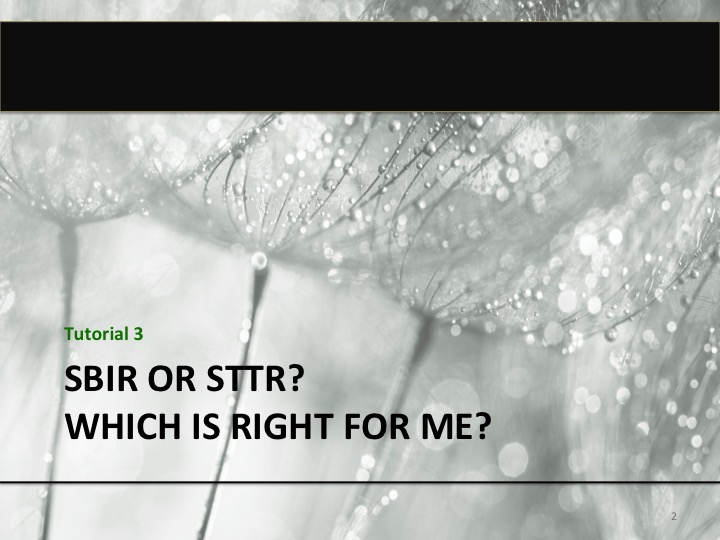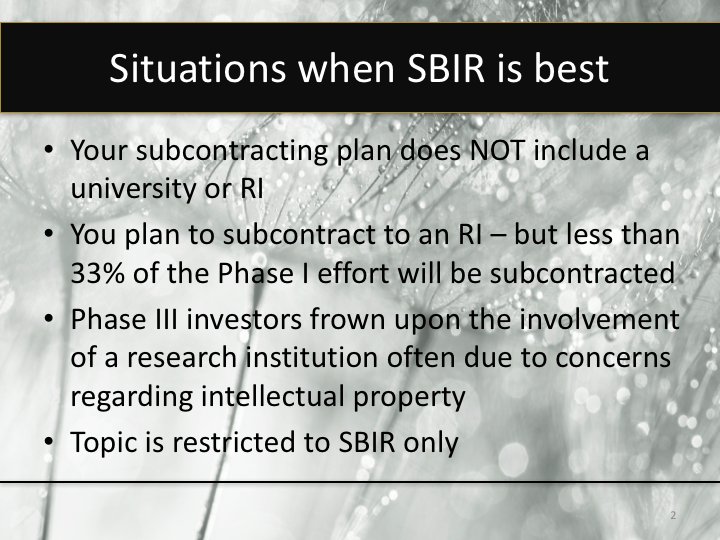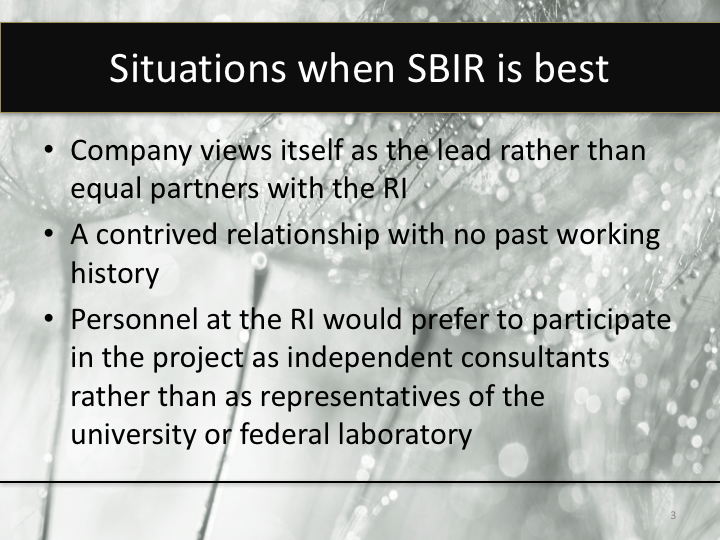Tutorial 3:
SBIR or STTR? Which is right for me?
In this tutorial we will look in greater detail at the differences between the Small Business Innovation Research (SBIR) and the Small Business Technology Transfer (STTR) programs. Both programs have three phases, and are focused on developing innovative solutions to pressing problems that can then be commercialized as new products and services or improvements to existing ones.
There are however two key differences between SBIR and STTR. First, an STTR project requires the small business – which is always the applicant – to be teamed with a non-profit research institution, typically a university or Federal Laboratory. The second difference is that STTR program is focused on the transfer of technology from the Research Institution also referred to as RI to the small business and ultimately to the marketplace through a Phase 1-2-3 sequence. This second difference has been expanded over time to include situations where the innovation belongs to the small business, but the firm desires to include important resources from a nonprofit RI in the technology’s development. Research institutions typically have sophisticated laboratories and personnel with needed expertise.
In addition to these two key differences, there are a number of other, more subtle differences between SBIR and STTR. One very important difference is the primary employment of the project’s principal investigator: in an SBIR project, the PI must be primarily employed at the proposing small business, meaning he/she cannot work full time elsewhere during the project period. With an STTR, the PI could be primarily employed at either the RI or the small business. Another important difference between the two programs is that up to 60% of the research effort for an STTR project can be subcontracted, whereas there is a 33% limit on Phase I SBIR subcontracting. The SBIR limit increases to 50% in Phase II, but is still less than what is allowed in STTR.
There are several misunderstandings about what can be funded with an STTR. One misunderstanding is that a university can apply for an STTR – this is incorrect because, per the name “Small Business Technology Transfer,” the applicant must be a small for-profit business. Another misunderstanding is that STTR is less focused on commercialization than SBIR—Congress and the agencies both intend STTR projects to lead to products and services in Phase III. And while it was once true that a project that began as an STTR in Phase I had to remain as an STTR in Phase II, the 2011 Reauthorization permits a Phase I STTR award to morph into an SBIR in Phase II, and vice versa.
Let’s now look at situations where it is best to apply for an SBIR award instead of an STTR. In general, the SBIR program will be a better opportunity in the following situations:
- When you submit an SBIR proposal you can include another company – large or small as a subcontractor. You can also include a university or another type of research institution such as a Federally funded Research Center or FFRDC as a subcontractor. However, if you don’t plan to include a non-profit research entity in your project at all, then you aren’t qualified for the STTR program and therefore this is not a consideration.
- It is up to a small business to decide if it makes sense to subcontract at all. If you decide to subcontract to an RI – but don’t need to subcontract more than 33% of a Phase I research effort to a research institution then SBIR is the most appropriate. You can still involve and work with a university or RI through an SBIR.
- Sometimes Phase III investors do not like the idea of non-profit involvement in a project, whether it be because of perceptions about the “culture” of such participants or concerns about the non-profit’s claim to intellectual property rights on the project. In this case an SBIR would be the most appropriate.
- If the topic is restricted to SBIR only (not accepting STTR proposals). While this happens relatively infrequently in the DOE programs, occasionally a topic will be restricted to SBIR applications only.
- If relationship to nonprofit sub is not for research or if company wants to maintain a leader/follower relationship. The former situation might exist if, for example, a small firm tries to subcontract through an STTR for a university to provide rats for the firm’s small animal studies. The latter, which might be a nuance, differentiates an STTR that expects your small business and the RI to be equal partners, versus an SBIR in which the small business is the lead entity.
- Small firms and RIs should not jump into a hastily contrived relationship with each other just to fit the STTR program. If these partners do not have a past working history, or if otherwise either party does not feel completely comfortable with the other, then an STTR should not be pursued and the small firm may opt to submit an SBIR instead that involves a less intensive, and less collaborative relationship.
- If the personnel at the RI would prefer to participate in the project as independent consultants rather than as representatives of the university or Federal Laboratory. A small firm hiring consultants does not qualify for STTR because there is no nonprofit RI acting as a subcontractor.
We’ve just outlined when it is best to consider SBIR – Now let’s now explore when it is best to consider STTR. STTR might be the better choice in the following situations:
- You need to subcontract a large portion of award. SBIR Phase I projects constrain the use of subcontractors because not more than 33% of the research can be subcontracted; STTR is much more generous, allowing for up to 60% of the R&D to go to the nonprofit RI.
- The Principal Investigator, also referred to as the PI is primarily employed at RI and wants to stay there. If, for example, the PI is tenured faculty at the RI, then he/she likely will want to maintain their primary employment there—this is allowed under a DOE STTR award.
- Small business and RI view themselves as equal partners on the project. Again, STTR is described as a “collaboration” between the two, suggesting the players are equals even though the award always goes to the small business and the firm must maintain overall control and has responsibility for the project.
- Sometimes the applicant may conclude that there is a greater probability of winning an award when teamed with an RI
- And of course, If a topic of interest is restricted to an STTR response then there is no opportunity to submit an SBIR proposal in response to it.
The DOE SBIR/STTR programs include a commendable feature that makes it easier to choose between the two programs. If the proposed project involves a nonprofit RI, and if the RI is not performing more than 33% of the research effort, then the applicant small business may request that their proposal be considered for funding under both SBIR and STTR programs. This is only available at DOE, and can give the applicant two chances at getting their project funded while only having to submit one proposal.
Quiz: Tutorial 3: SBIR or STTR? Which one is right for me?
1
The main difference between SBIR and STTR is that the SBIR program requires that the small business team with a university, federal lab, or other nonprofit research institution
Nice Work
Try Again
2
Which of the following statements is NOT accurate?
Nice Work
Try Again
3
Where can the principal investigator on a DOE STTR project have their primary employment?
Nice Work
Try Again
4
If a small business applicant wants to be considered for both SBIR and STTR at the Department of Energy, how many proposals does it have to submit?
Nice Work
Try Again
5
Which of the following statements is inaccurate?
Nice Work
Try Again


